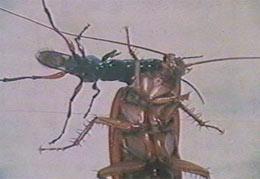Zombie insects might sound like the B-movie plot device from heaven (or hell, depending on your cinematic preferences). But to the emerald cockroach wasp (Ampulex compressa ), they're a tried and tested way to provide food for their hungry larvae.

|
| ©Libersat |
| Sting in the brain: a toxic injection renders cockroaches submissive. |
The wasp, which lives in tropical regions of Africa, India and the Pacific Islands, relies on cockroaches for its grisly life cycle. But unlike many venomous predators, which paralyse their victims before eating them or dragging them back to their lair, the wasp's sting leaves the cockroach able to walk, but unable to initiate its own movement.
The wasp then grabs the cockroach's antenna and leads it back to the nest. The cockroach walks "like a dog on a leash", says Frederic Libersat of Ben-Gurion University of the Negev in Israel, who led the research and has previously described the wasps' behaviour in detail. Once home, the merciless wasp lays an egg on the docile cockroach's belly, and the larva, once hatched, devours the hapless insect (see video Wasp voodoo rituals and cockroach zombies in the French Polynesian Islands).
Toxic cocktail
But although the zombie cockroach phenomenon has been well documented, Libersat and his colleagues still didn't know how exactly the wasps pull off the trick. "We know the wasp injects a rich cocktail of toxins," Libersat says. But it was unclear how the venom could alter the victims' behaviour so subtly.
The researchers knew that the wasps tend to sting the cockroaches once to subdue them, then adminster another, more precise sting right into their victim's brain. So they suspected that the venom might work by blocking a key chemical messenger.
The results of their latest experiment, published in the Journal of Experimental Biology 1, support that theory. The researchers report that the venom works to block a neurotransmitter called octopamine, which is involved in preparations to execute complex behaviours such as walking.
Libersat and his team found that they could restore spontaneous walking behaviour in stung cockroaches by giving them a compound that reactivates octopamine receptors in the insects' central nervous system. This, they conclude, means that the wasp venom probably blocks these receptors.
What's more, the researchers discovered that injecting unstung cockroaches with a compound that blocks these receptors produced a similar effect to that of the venom.



I have written three books that touch the basics of this kind of mind control as it relates to the techniques targeted for humans. Never have I seen an admission that they had an ANTIDOTE to these toxins.
Other research shows that there are neurotransmitter functions that have been conserved over millions of years that are shared by the cockroach and human.
How many people today do you know that can be led by their antennae?
There is an antidote.
A molecular switch.
It is your duty as a living, thinking hominid to discover this antidote's chemical formula and disseminate it to the world so that a safe analog for humans can be held in reserve to protect us from the end results of this kind of Delgado chemoexperimentation:
You're next!